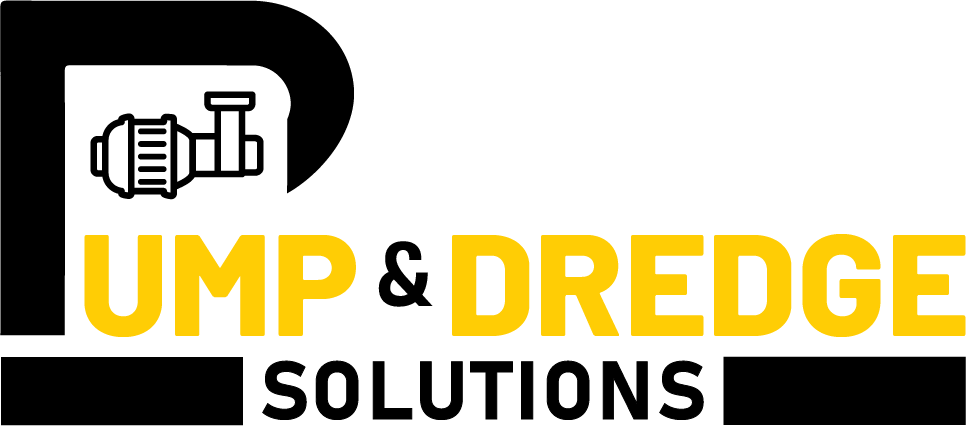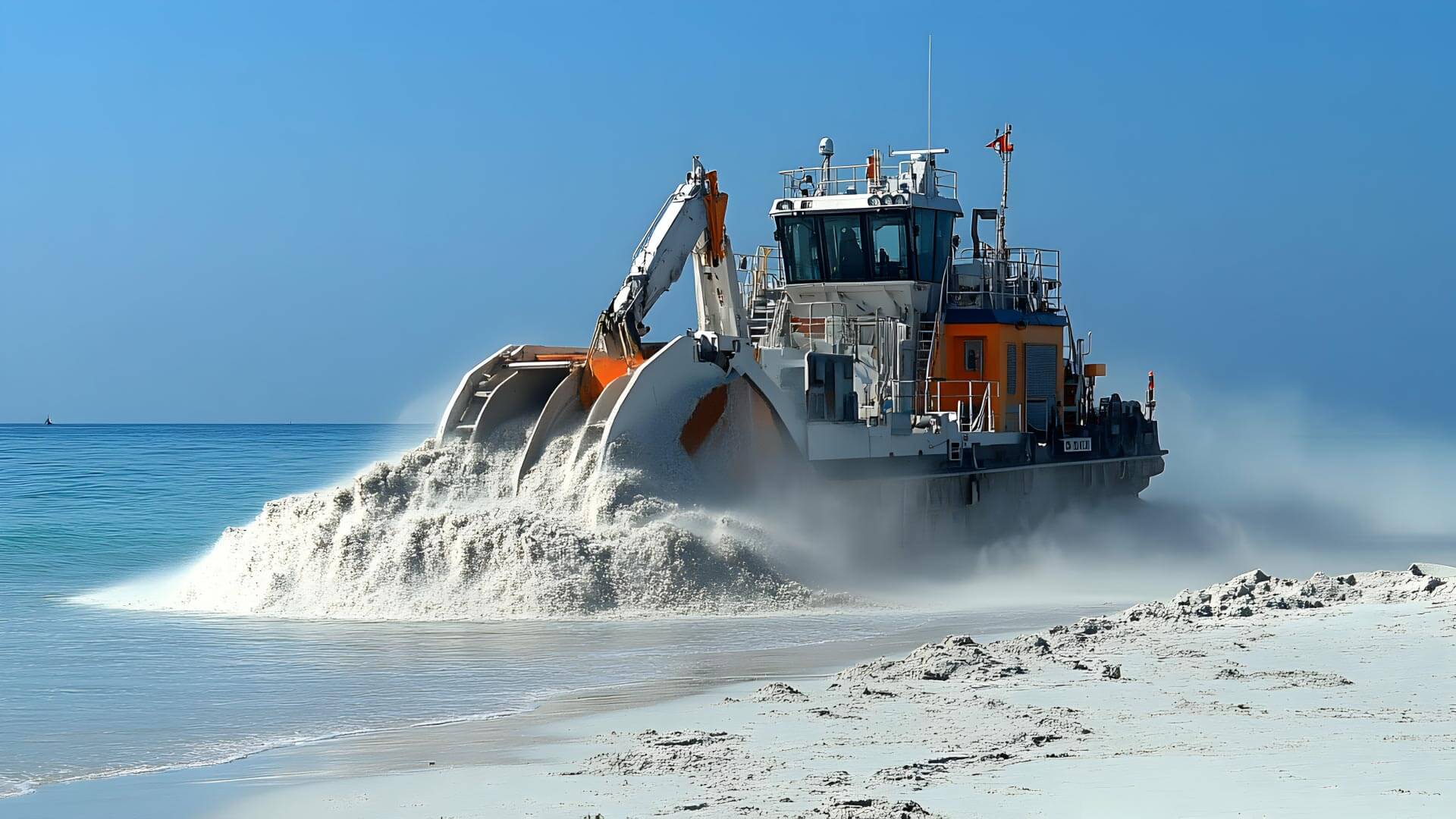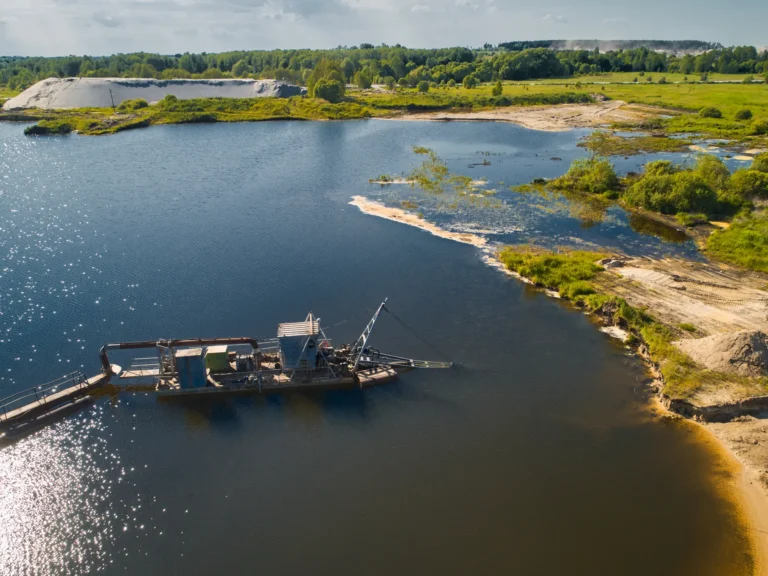Dredging is crucial for maintaining and managing water bodies, ensuring their functionality and ecological balance. It involves removing sediment, debris, and other materials from the bottom of rivers, lakes, harbors, and other aquatic environments. This process is essential for various purposes, including restoring navigability, improving water quality, and preventing flooding. Among the different dredging methods available, hydraulic dredging stands out as one of the most efficient and versatile solutions for a wide range of applications.
Hydraulic dredging uses powerful suction systems to remove and transport sediment, making it ideal for projects that require precision and speed. A key aspect of its effectiveness is the advanced equipment, which includes dredge pumps, cutter heads, and pipelines that ensure smooth operations. With this specialized equipment, hydraulic dredging can handle complex challenges, such as managing sediment in deep or hard-to-reach areas.
In this blog, we’ll explore the hydraulic dredging process, breaking it down into simple steps and highlighting its benefits. We’ll also delve into the essential components of hydraulic dredging equipment and discuss the wide-ranging applications of this highly efficient method, from environmental restoration to port maintenance.
What is Hydraulic Dredging?

Hydraulic dredging is a specialized technique for removing sediment, debris, and other materials from the bottom of water bodies using suction and pipeline systems. It involves using high-powered pumps to create a vacuum that extracts sediment, which is then transported through pipelines to designated disposal or reuse locations. This method is highly efficient, especially for large-scale dredging projects, as it allows for continuous sediment removal and transport in a streamlined operation.
Unlike mechanical dredging, which relies on excavators or buckets to scoop sediment physically, hydraulic dredging is less invasive and more suited for environments that require precision or where large volumes of material need to be moved. Mechanical dredging is often used in small, confined areas, but its intensive physical approach can disrupt aquatic habitats. In contrast, hydraulic dredging minimizes ecological disturbance and offers faster, more efficient sediment removal, particularly for projects in lakes, rivers, and harbors.
The success of any hydraulic dredging operation largely depends on selecting the right equipment. Key components, such as cutter heads, dredge pumps, and pipelines, ensure the process runs smoothly and effectively. Using equipment tailored to a project’s specific requirements not only optimizes efficiency but also reduces downtime and operational costs.
This method, which implements the hydraulic dredging process and leverages advanced equipment, can handle a wide variety of dredging challenges. It is ideal for projects requiring precision, speed, and minimal environmental impact. It is also indispensable for maintaining navigational routes, restoring aquatic ecosystems, and managing sediment in water bodies of all sizes.
The Hydraulic Dredging Process

The hydraulic dredging process is a systematic approach that enables efficient sediment removal and transportation from water bodies. It consists of several key steps, each crucial to ensuring the project’s success while minimizing environmental impact.
- Site Assessment and Planning
Before the operation begins, a detailed assessment of the site is conducted. This involves analyzing the water body’s depth, sediment composition, and environmental factors. Proper planning ensures that the hydraulic dredging process is tailored to meet the specific needs of the project. - Deployment of Hydraulic Dredging Equipment
The next step is to deploy the appropriate hydraulic dredging equipment, including dredge pumps, cutter heads, and pipelines. Choosing the right equipment is critical for achieving operational efficiency and adapting to the site’s unique conditions. - Sediment Suction Using Dredge Pumps
High-powered dredge pumps create suction, extracting sediment from the water body. Cutterheads may be employed to break up compact materials, making it easier to transport the sediment through the system. - Transporting Sediment via Pipelines or Hoses
The extracted sediment is transported through pipelines or hoses to designated disposal sites or locations for reuse. Booster pumps may be added to the system to maintain flow over long distances. - Disposal or Reuse of Dredged Material
The final step involves responsibly disposing of or reusing the dredged material for purposes such as land reclamation, habitat restoration, or construction.
The hydraulic dredging process is adaptable to different water bodies, from lakes to harbors, and can handle a wide range of sediment types. By using advanced hydraulic dredging equipment, this method ensures efficiency, precision, and minimal environmental disruption, making it a highly effective solution for managing sediment and maintaining water bodies.
Key Components of Hydraulic Dredging Equipment
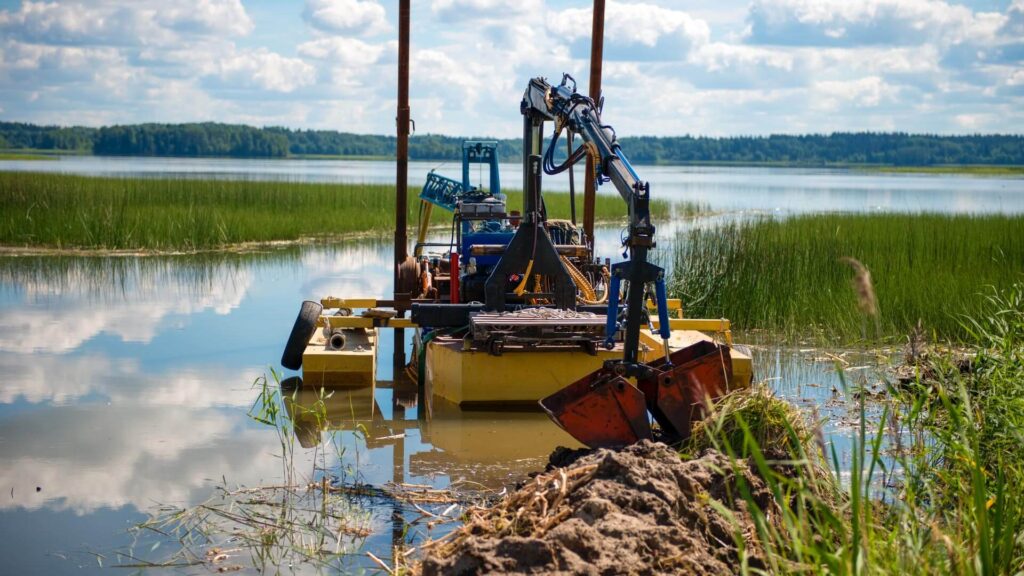
Hydraulic dredging relies on specialized equipment to ensure efficiency and precision throughout the operation. Each component plays a crucial role in the hydraulic dredging process, enabling the seamless removal and transportation of sediment from water bodies. Here’s an overview of the essential equipment used:
- Dredge Pumps
Dredge pumps are the heart of any hydraulic dredging operation. They create the suction force necessary to remove sediment from the water body and transport it through pipelines. Depending on the project, pumps may vary in size and capacity, from small portable units to large, high-powered systems capable of handling significant sediment loads. - Cutterheads
Cutterheads are vital for breaking up compacted or cohesive sediment, making it easier to extract and transport. They are often mounted on the dredge head and come in various designs tailored to specific sediment types, such as clay, silt, or sand. - Pipelines and Hoses
Pipelines and hoses serve as the conduits for transporting dredged material to designated disposal or reuse sites. Their durability and flexibility are essential, especially in projects requiring long-distance sediment transport. - Booster Pumps
Booster pumps are added to maintain flow and pressure in extended pipeline operations. These pumps enhance the efficiency of the hydraulic dredging process, particularly in large-scale projects.
Selecting the right hydraulic dredging equipment is critical to operational success. Factors such as sediment composition, waterbody depth, and project scale influence the choice of equipment. Technological advances, such as automated controls and eco-friendly systems, continue to enhance the efficiency and sustainability of hydraulic dredging.
The hydraulic dredging process can be executed with precision and minimal environmental impact by using the appropriate tools and staying updated on technological developments.
Applications of Hydraulic Dredging
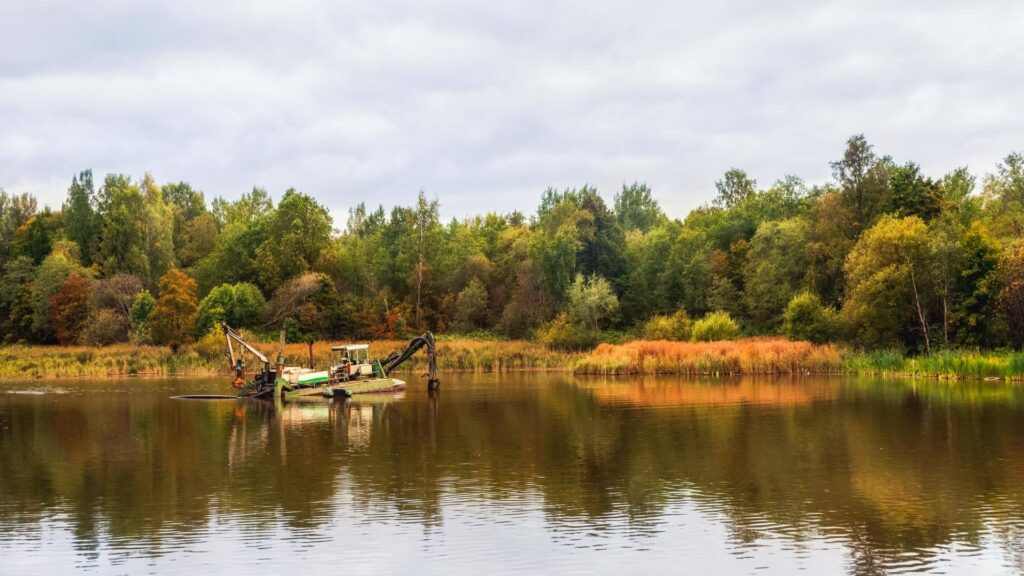
Hydraulic dredging is a versatile technique used across a wide range of industries to address various challenges associated with sediment removal and waterbody maintenance. The hydraulic dredging process is tailored to meet the unique requirements of each application, ensuring effective results and minimal environmental impact. Here are some of its key applications:
- Environmental Restoration
Hydraulic dredging is vital in restoring aquatic ecosystems by removing contaminated sediments and toxic materials. This helps improve water quality and revitalize habitats for aquatic life. Using specialized hydraulic dredging equipment, precise sediment removal can be achieved without significantly disrupting the environment. - Navigational Maintenance
Ports, harbors, and shipping channels require regular dredging to maintain navigability and ensure the safe passage of vessels. The hydraulic dredging process allows for efficient sediment removal in these high-traffic areas, preventing blockages and reducing risks to maritime operations. - Lake and Reservoir Management
Sedimentation in lakes and reservoirs can lead to reduced storage capacity and water quality. Hydraulic dredging equipment is used to manage sediment levels, improve water clarity, and restore recreational and ecological value to these water bodies. - Mining and Resource Extraction
Hydraulic dredging is widely used in mining operations to extract sand, gravel, and other minerals from riverbeds and underwater deposits. It enables high-volume material removal while maintaining cost efficiency. - Construction Projects
Land reclamation and foundation preparation for construction projects often involve hydraulic dredging equipment, which relocates sediment and prepares stable land bases.
Industries can efficiently address diverse challenges while ensuring sustainable practices by utilizing the hydraulic dredging process and appropriate equipment. These applications demonstrate the versatility and effectiveness of hydraulic dredging in managing sediment and improving waterway functionality.
Benefits of Hydraulic Dredging
Hydraulic dredging offers numerous advantages, making it the preferred method for a variety of sediment removal projects. The hydraulic dredging process is designed to deliver high efficiency, precision, and minimal environmental disruption, making it a valuable solution for industries managing water bodies.
- High Efficiency in Sediment Removal and Transport
The hydraulic dredging process is highly effective for removing large volumes of sediment in a short amount of time. The continuous operation of suction pumps and sediment transport systems enables seamless dredging, reducing project duration and increasing productivity. - Minimal Disruption to Aquatic Ecosystems
Hydraulic dredging is less invasive than mechanical dredging. Its precision and controlled operations significantly reduce disturbances to aquatic habitats, protecting marine life and maintaining ecological balance. - Cost-Effectiveness for Large-Scale Projects
Hydraulic dredging is particularly cost-effective for extensive projects, such as maintaining harbors, ports, or reservoirs. The process requires fewer labor-intensive operations and can efficiently handle significant sediment volumes, reducing overall project costs. - Flexibility to Work in Diverse Environments
Hydraulic dredging is adaptable to various water bodies, from shallow lakes to deep ports. Customizing the process with the appropriate equipment ensures it meets the specific demands of different environments and sediment types. - Role of Well-Maintained Hydraulic Dredging Equipment
The performance of the hydraulic dredging process heavily depends on the condition and suitability of the equipment used. Well-maintained hydraulic dredging equipment, including pumps, cutter heads, and pipelines, ensures operational efficiency, reduces downtime, and extends the lifespan of the machinery.
In conclusion, the hydraulic dredging process, supported by the right equipment, delivers unmatched efficiency, environmental care, and versatility, making it a trusted choice for a wide range of dredging projects.
Challenges and Considerations in Hydraulic Dredging
While hydraulic dredging is a highly effective sediment removal method, it is not without its challenges. Several factors can impact the process’s efficiency and success, requiring careful planning and execution. Below are some common challenges and strategies for effectively addressing them.
- Dealing with Hard or Compact Sediments
One primary challenge is working with hard or compacted sediment that is difficult to break apart. Specialized cutter heads and other advanced hydraulic dredging equipment can help overcome this issue by efficiently loosening the material for easier extraction. - Managing Long-Distance Sediment Transport
Transporting sediment over long distances can strain pipelines and pumps, reducing efficiency. Incorporating booster pumps into the hydraulic dredging process helps maintain consistent flow and pressure, ensuring sediment is transported effectively without equipment failures. - Environmental Regulations and Permitting Processes
Dredging projects are often subject to strict environmental regulations and permitting requirements. These can delay project timelines and increase costs. To address this, thorough site assessments and collaboration with regulatory bodies are essential to ensure compliance. Using eco-friendly hydraulic dredging equipment also helps minimize environmental impact, aligning with legal standards.
Tips for Overcoming These Challenges
- Using Advanced Equipment
Leveraging cutting-edge hydraulic dredging equipment with precision tools and monitoring systems enhances efficiency and ensures better handling of difficult conditions. - Employing Skilled Operators and Consultants
Experienced operators and consultants bring the expertise needed to manage the complexities of the hydraulic dredging process, ensuring smooth execution and problem resolution. - Conducting Thorough Site Assessments
Detailed site evaluations help identify potential challenges early, enabling the project team to develop tailored strategies for success.
Proper planning, skilled personnel, and advanced hydraulic dredging equipment can help the hydraulic dredging process achieve optimal results even in demanding scenarios.
Conclusion
Hydraulic dredging is an efficient and versatile method for removing sediment, restoring water bodies, and supporting a wide range of applications, from environmental restoration to navigational maintenance and resource extraction. Its process enables precise sediment removal and transport, making it a preferred choice for projects requiring efficiency and environmental care. Its adaptability to various environments and sediment types further enhances its appeal to industries and environmental initiatives alike.
One critical factor in ensuring successful operations is selecting and using the right hydraulic dredging equipment. From dredge pumps and cutter heads to pipelines and booster pumps, each component plays a vital role in optimizing efficiency, reducing project downtime, and minimizing environmental impact. Pairing advanced equipment with skilled operators and thorough planning ensures smooth execution, even in challenging scenarios.
In the broader context of waterway management, hydraulic dredging is an indispensable tool for maintaining navigability, improving water quality, and protecting aquatic ecosystems. With its proven ability to address sediment-related challenges, hydraulic dredging continues to play a pivotal role in sustaining and restoring the health of water bodies worldwide.
